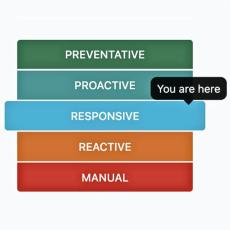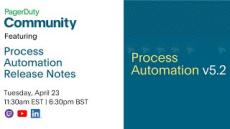|
By PagerDuty
PagerDuty, Inc announces the appointment of Eduardo Crespo as vice president of EMEA. Crespo will lead PagerDuty's next phase of growth in the EMEA region bringing the PagerDuty Operations Cloud to enterprise customers across EMEA to solve their biggest digital challenges.
|
By Mandi Walls
Figuring out how to represent your as-built environment in PagerDuty can be confusing for new users. There are a lot of components to PagerDuty that will help your team be successful managing incidents, integrating with other systems in your environment, running workflows, and using automation. Your organization might have a lot of these components – users, teams, services, integrations, orchestrations, etc.
|
By Hannah Culver
Many organizations are heavily investing in AI and automation to remove the burden of manual work and operational efficiency. However to drive their wide scale adoption, they also need employees who can collaborate effectively with the technology. To bridge that gap, companies can use upskilling to retain talent, mitigate risks to the business, and allow employees to grow their careers.
|
By Alex Quintana
A top priority for many technical leaders is improving the performance and efficiency of their teams to maximize results and minimize costs. With the PagerDuty Operational Maturity Model, IT teams can reduce the total cost of ownership with better efficiency, mitigate the risk of operational failure to ultimately protect customer experience, and shift from a reactive state towards a more proactive approach—by using the PagerDuty Operations Cloud.
|
By Jesse Purewal
Mitigating the risk of operational failure is top of mind—and a top budget priority—for executives. A single unplanned event can have a disruptive effect across the organization, an outcome management teams work hard to avoid. For the New York Stock Exchange (NYSE), operational resilience is critical given the role it plays in the global economy and capital flows.
|
By Debbie O'Brien
For someone experiencing a mental health or substance abuse crisis, receiving timely access to care is critical. Recognizing a growing need for behavioral health intervention, San Diego County launched its Telecare Mobile Crisis Response Team (MCRT) to provide no-cost, in-person support. “With mental health crises on the rise, counties are trying to figure out how to implement something that supports folks in the community,” said Bre Lane, Program Administrator at MCRT.
|
By Mandi Walls
Incidents impacting your customer and user-facing services can be stressful, both for the responders on your team who are working on a resolution, and for the other stakeholders in your business. For teams to solve incidents quickly and effectively, responders need to be able to trust each other and stakeholders have to trust the responders. This level of trust is hard to cultivate if your organization doesn’t have a significant amount of psychological safety.
|
By PagerDuty
98% of top tech execs paused their corporate genAI initiatives to establish policies. Execs say that a trusted technology partner is key to incorporating genAI into their organizations.
|
By PagerDuty
Offering includes innovations that provide end-to-end incident management to mitigate lost revenue and reputational risk while replacing point solutions.
|
By Laura Chu
Mitigating business risk is a key enterprise priority. To avoid unnecessary exposure to the business, technical teams need a proactive approach to managing incidents. While this is a well-known challenge, it’s also much easier said than done. Over the years, many organizations have cobbled together their own bespoke processes for managing different types of incidents.
|
By PagerDuty
Incidents happen. PagerDuty helps you automate incident management end-to-end, allowing you to work where you want and integrate with all your tools.
|
By PagerDuty
PagerDuty helps organizations manage the entire incident lifecycle to respond faster and more effectively while reducing costs. Move from manual, reactive incident management to an automated, proactive approach, making the incident response process more efficient and resilient.
|
By PagerDuty
PagerDuty AIOps works out of the box reducing noise, creating context and automating toil so that teams can enjoy fewer incidents, faster resolution and greater productivity. Learn more in less than two minutes.
|
By PagerDuty
Watch the first virtual meetup for the PagerDuty plugin for Backstage. This informal gathering is for plugin users and contributors. Learn why PagerDuty continues to invest in this open-source project, which aims to solve significant challenges for software development and engineering teams. Developer Advocate and project maintainer Tiago Barbosa presents success metrics, reviews the work accomplished so far, and discusses the future feature roadmap openly.
|
By PagerDuty
Developer Advocate Mandi Walls and Solutions Consultant Taz Ishraque explore the power of Change Events in the PagerDuty Operations Cloud. Watch and learn: How PagerDuty's Change Events API and integrations streamline the transmission of critical updates How Change Correlations enhance incident triage How to accelerate incident resolutions, reduce context switching and help teams focus on innovative work instead of firefighting.
|
By PagerDuty
How prepared is your team to handle outages or system failures? PagerDuty’s Operational Maturity Model helps organizations plot their path to more resilient operations. Learn more in less than 2 minutes.
|
By PagerDuty
Status Pages REST API is now generally available! Join us as we discuss some of its capabilities and look at some cool use cases.
|
By PagerDuty
Supporting developer velocity AND operational efficiency, stability, and security doesn't happen by accident. In this episode, Dormain will sit down with Paula Kennedy to discuss how platform engineering supports businesses go faster, decrease risk, and increase efficiency.
|
By PagerDuty
Chat with the PagerDuty Process Automation product management team. Join us to learn more about what's new in the new release - v5.2 - and what's coming for automation!
|
By PagerDuty
Elevate your biz & enhance your automation skills! Get together with the Rundeck by PagerDuty Process Automation crew and learn how automation is leading the way to innovation and fast tracking business for the future!🚀 Hear success automation stories from Diego Infiesta (IT Infrastructure Manager @ Ryanair) & Hans Erasmus (Director @ HBPS Consulting), and dive into the world of open-source automation with James Pickles (Solutions Consultant @ PagerDuty).
|
By PagerDuty
To meet the rising demands of customers, organizations are being forced to scale their operations in ways that introduce additional complexity and chaos. More people are involved in operations and in incident response, across an ever-increasing mix of systems, applications, tools, and layers of abstraction, resulting in more and more risk to the business.
|
By PagerDuty
Given the speed at which technology and consumer expectations are changing, there are now significant gaps in existing ITSM approaches. As a result, ITSM and ITIL processes need to be modernized to address needs around integrating legacy processes and tools, to create workflows that are built around people to maximize flexibility and ease of use.
|
By PagerDuty
This study reviewed a combination of notification statistics and their impact on the well-being and work-life balance of human responders to help answer this question: When does on-call pain lead to employee attrition and how can it be avoided?
|
By PagerDuty
When your monitoring systems generate too many issues that require your attention, your organization starts to suffer from the phenomenon known as alert fatigue. Once alert fatigue sets in, it impacts the services you deliver to employees and customers. Teams become desensitized to alerts, which can cause them to miss critical notifications.
|
By PagerDuty
In this e-book, we introduce a new approach to AIOps that eliminates silos between event and incident management, has helped customers reduce noise on average by 98%, and supports both centralized and distributed workflows in harmony.
|
By PagerDuty
Organizations today require disruption in security management, which means not only modernizing security tools and best practices, but also involving more stakeholders in security ops, streamlining communication about security incidents, and coordinating responses efficiently and rapidly. It means embracing SecOps, a new approach to security management.
|
By PagerDuty
DevOps best practices can benefit all types of organizations, across all industries. Nearly half of enterprises have already begun adopting DevOps, and most of the remainder have plans to do so. If your org doesn't make the shift to DevOps, it risks being disrupted by others that achieve greater agility, automation, and communication.
|
By PagerDuty
In order to continue pleasing your customers in today's rapidly changing digital landscape, you need to adapt your customer support operations to meet this new set of expectations. Instant responses, zero service disruptions, and multiple channels of engagement are the new normal for customer relations. Companies that fail to live up to these ideals risk losing customers and falling behind.
|
By PagerDuty
How critical is incident resolution at your company? When the estimated cost of downtime is $7,900 a minute, how do you ensure you're setting yourself up for success with the right incident management solution?
|
By PagerDuty
From POS systems to QR systems, building management, mobile devices, IoT, and more, retailers must deliver a seamless omnichannel experience to stay ahead of the competition. But are you equipped to provide reliable digital services while continuing to deliver innovation?
- May 2024 (10)
- April 2024 (7)
- March 2024 (12)
- February 2024 (8)
- January 2024 (13)
- December 2023 (6)
- November 2023 (17)
- October 2023 (23)
- September 2023 (16)
- August 2023 (22)
- July 2023 (16)
- June 2023 (19)
- May 2023 (10)
- April 2023 (13)
- March 2023 (4)
- February 2023 (13)
- January 2023 (11)
- December 2022 (10)
- November 2022 (13)
- October 2022 (11)
- September 2022 (12)
- August 2022 (15)
- July 2022 (10)
- June 2022 (12)
- May 2022 (5)
- April 2022 (7)
- March 2022 (7)
- February 2022 (8)
- January 2022 (19)
- December 2021 (9)
- November 2021 (16)
- October 2021 (27)
- September 2021 (11)
- August 2021 (16)
- July 2021 (25)
- June 2021 (17)
- May 2021 (10)
- April 2021 (9)
- March 2021 (18)
- February 2021 (9)
- January 2021 (6)
- December 2020 (9)
- November 2020 (9)
- October 2020 (9)
- September 2020 (12)
- August 2020 (6)
- July 2020 (9)
- June 2020 (15)
- May 2020 (8)
- April 2020 (6)
- March 2020 (9)
- February 2020 (5)
- January 2020 (5)
- December 2019 (2)
- November 2019 (9)
- October 2019 (11)
- September 2019 (11)
- August 2019 (8)
- July 2019 (10)
- June 2019 (11)
- May 2019 (13)
- April 2019 (13)
- March 2019 (14)
- February 2019 (9)
- January 2019 (6)
- December 2018 (9)
- November 2018 (13)
- October 2018 (15)
- September 2018 (15)
- August 2018 (6)
- July 2018 (2)
- June 2018 (11)
- May 2018 (6)
- April 2018 (14)
- March 2018 (1)
- February 2018 (2)
- January 2018 (1)
Enterprise-grade incident management that helps you orchestrate the ideal response to create better customer, employee, and business value.
Visualize every dimension of the customer experience with contextual insights and interactive applications, and optimize response orchestration and continuous development and delivery:
- Event Intelligence: Understand the health and common context of disruptions across your entire infrastructure with actionable, time-series visualizations of correlated events.
- Modern Incident Response: All teams get the same visibility for technical and business response orchestration, enabling better collaboration and rapid resolution.
- Continuous Learning: Discover patterns in performance during build and in production for continuous delivery. View postmortem reports to analyze system efficiency and employee agility.

















